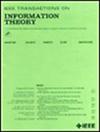Channel Simulation: Finite Blocklengths and Broadcast Channels
IF 2.9
3区 计算机科学
Q3 COMPUTER SCIENCE, INFORMATION SYSTEMS
引用次数: 0
Abstract
We study channel simulation under common randomness assistance in the finite-blocklength regime and identify the smooth channel max-information as a linear program one-shot converse on the minimal simulation cost for fixed error tolerance. We show that this one-shot converse can be achieved exactly using no-signaling-assisted codes, and approximately achieved using common randomness-assisted codes. Our one-shot converse thus takes on an analogous role to the celebrated meta-converse in the complementary problem of channel coding, and we find tight relations between these two bounds. We asymptotically expand our bounds on the simulation cost for discrete memoryless channels, leading to the second-order as well as the moderate-deviation rate expansion, which can be expressed in terms of the channel capacity and channel dispersion known from noisy channel coding. Our bounds imply the well-known fact that the optimal asymptotic rate of one channel to simulate another under common randomness assistance is given by the ratio of their respective capacities. Additionally, our higher-order asymptotic expansion shows that this reversibility falls apart in the second order. Our techniques extend to discrete memoryless broadcast channels. In stark contrast to the elusive broadcast channel capacity problem, we show that the reverse problem of broadcast channel simulation under common randomness assistance allows for an efficiently computable single-letter characterization of the asymptotic rate region in terms of the broadcast channel’s multipartite mutual information.信道模拟:有限块长和广播信道
我们研究了有限块长机制下普通随机性辅助下的信道模拟,并将平滑信道最大信息确定为固定误差容限下最小模拟成本的线性程序一次反演。我们证明,使用无信号辅助编码可以精确地实现这一单次反演,而使用普通随机性辅助编码则可以近似地实现这一单次反演。因此,我们的一次反演与信道编码互补问题中著名的元反演具有类似作用,而且我们发现了这两个界限之间的紧密关系。我们渐进地扩展了离散无记忆信道的模拟成本边界,从而实现了二阶以及中等偏差率扩展,这可以用噪声信道编码中已知的信道容量和信道色散来表示。我们的界限意味着一个众所周知的事实,即在共同随机性辅助下,一个信道模拟另一个信道的最佳渐进速率由它们各自容量的比值给出。此外,我们的高阶渐近展开表明,这种可逆性在二阶时就不复存在了。我们的技术可扩展到离散无记忆广播信道。与难以捉摸的广播信道容量问题形成鲜明对比的是,我们证明了在共同随机性辅助下的广播信道模拟的反向问题,可以根据广播信道的多方互信息对渐近速率区域进行高效的单字母表征。
本文章由计算机程序翻译,如有差异,请以英文原文为准。
求助全文
约1分钟内获得全文
求助全文
来源期刊

IEEE Transactions on Information Theory
工程技术-工程:电子与电气
CiteScore
5.70
自引率
20.00%
发文量
514
审稿时长
12 months
期刊介绍:
The IEEE Transactions on Information Theory is a journal that publishes theoretical and experimental papers concerned with the transmission, processing, and utilization of information. The boundaries of acceptable subject matter are intentionally not sharply delimited. Rather, it is hoped that as the focus of research activity changes, a flexible policy will permit this Transactions to follow suit. Current appropriate topics are best reflected by recent Tables of Contents; they are summarized in the titles of editorial areas that appear on the inside front cover.
 求助内容:
求助内容: 应助结果提醒方式:
应助结果提醒方式:


